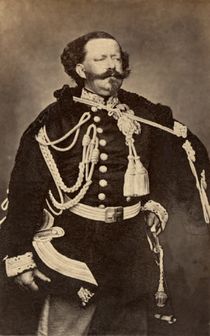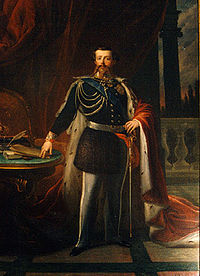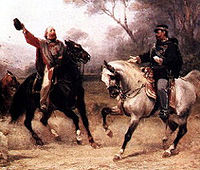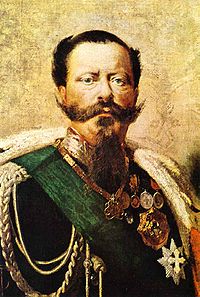Victor Emmanuel II of Italy
| Vittorio Emmanuele II | |
|---|---|
| King of Sardinia King of Italy |
|
 |
|
|
|
|
| Reign | 23 March 1849 – 17 March 1861 |
| Predecessor | Charles Albert |
|
|
|
| Reign | 17 March 1861 – 9 January 1878 |
| Successor | Humbert I |
| Spouse | Adelaide of Austria Rosa Vercellana |
| Issue | |
| Princess Maria Clotilde Umberto I of Italy Amedeo I of Spain Maria Pia, Queen of Portugal |
|
| Full name | |
| Vittorio Emanuele Maria Alberto Eugenio Ferdinando Tommaso di Savioa | |
| Father | Charles Albert |
| Mother | Maria Theresa of Austria |
| Born | 14 March 1820 Palazzo Carignano, Turin, Kingdom of Sardinia |
| Died | 9 January 1878 (aged 57) Rome, Kingdom of Italy |
| Burial | Pantheon, Rome |
Vittorio Emanuele II (English: Victor Emmanuel II) (Vittorio Emanuele Maria Alberto Eugenio Ferdinando Tommaso; 14 March 1820 – 9 January 1878) was the King of Piedmont, Savoy, and Sardinia from 1849 to 1861. On 17 March 1861, he assumed the title King of Italy to become the first king of a united Italy, a title he held until his death in 1878. The Italians gave him the epithet Father of the Fatherland (Italian: Padre della Patria).
Contents |
Biography

Vittorio Emanuele was born the eldest son of Charles Albert of Sardinia and Maria Theresa of Austria. His father was King of Sardinia. He lived for some years of his youth in Florence and showed an early interest in politics, the military, and sports. In 1842 he married his cousin Adelaide of Austria. He was styled as the Duke of Savoy prior to becoming King of Sardinia.
He took part in the First Italian War of Independence under his father, fighting in the front line at the battles of Pastrengo, Santa Lucia, Goito and Custoza.
He became King of Piedmont in 1849 when his father had abdicated the throne after a humiliating military defeat by the Austrians at Novara. Vittorio Emmanuele was immediately able to obtain a rather favorable armistice at Vignale by the Austrian commander, Radetzky. The treaty, however, was not ratified by the Piedmontese chamber, and Vittorio Emmanuele retaliated by firing Prime Minister Claudio Gabriele de Launay, replacing him with Massimo D'Azeglio. After new elections, the peace with Austria was accepted by the new Chamber of Deputies. In 1849 he also fiercely suppressed the revolt in Genoa, defining the rebels as a "vile and infected race of canailles".
In 1852, Vittorio Emmanuele II gave Count Camillo di Cavour the title of Prime Minister. This turned out to be a wise choice because Cavour was a political mastermind and a major player in Italian unification in his own right. Vittorio Emmanuele II soon became the symbol of the Italian Risorgimento, the Italian unification movement. He was especially popular in the Kingdom of Sardinia because of his respect for the new constitution and his liberal reforms.
Crimean War
Following Vittorio Emmanuele's advice, Cavour joined Britain and France in the Crimean War against Russia. Cavour was reluctant to go to war due to the power of Russia at the time and the expense of doing so. Vittorio Emmanuele, however, was convinced of the rewards to be gained from the alliance created between Britain and, more importantly, France.
After successfully seeking British support and ingratiating himself with France and Napoleon III at the Congress of Paris in 1856 at the end of the war, Count Cavour arranged a secret meeting with the French emperor. In 1858, they met at Plombières-les-Bains (in Lorraine), where they agreed that if the French were to help Piedmont combat Austria, which still occupied Kingdom of Lombardy-Venetia in northern Italy, France would be awarded Nice and Savoy.
At the time, Vittorio Emmanuele had become a universal symbol of the Italian Risorgimento, the movement pushing towards the unification of Italy.
Wars of Italian Unification
The Italo-French campaign against Austria in 1859 started successfully. However, sickened by the casualties of the war and worried about the mobilisation of Prussian troops, Napoleon III secretly made a treaty with Franz Joseph of Austria at Villafranca whereby Piedmont would only gain Lombardy. France did not as a result receive the promised Nice and Savoy, but Austria did keep Venetia, a major setback for the Piedmontese, in no small part because the treaty had been prepared without their knowledge. After several quarrels about the outcome of the war, Cavour resigned, and the king had to find other advisors. France indeed only gained Nice and Savoy after the Treaty of Turin was signed in March 1860 after Cavour has been reinstalled as Prime Minister and a deal with the French was struck for plebiscites to take place in the Central Italian Duchies.
Later that same year, Vittorio Emmanuele II sent his forces to fight the papal army at Castelfidardo and drove the Pope into Vatican City. Vittorio Emmanuel II’s success at these goals got him excommunicated from the Catholic Church. Then, Giuseppe Garibaldi conquered Sicily and Naples, and Sardinia-Piedmont grew even larger. On 17 March 1861 the Kingdom of Italy was officially established and Vittorio Emmanuele II became its king.

Vittorio Emmanuele supported Giuseppe Garibaldi's Expedition of Thousand (1860-1861), which resulted in the quick fall of the Kingdom of the Two Sicilies in southern Italy. However, the King halted Garibaldi when he appeared ready to attack Rome, still under the Papal States, as it was under French protection. In 1860, through local authoritarian plebiscites, Tuscany, Modena, Parma and Romagna decided to side with Sardinia-Piedmont. Vittorio Emmanuele then marched victoriously in the Marche and Umbria after the victorious battle of Castelfidardo (1860) over the Papal forces, after which he gained a Papal excommunication.
The King subsequently met with Garibaldi at Teano, receiving from him the control of southern Italy. Another series of plebiscites in the occupied lands resulted in the proclamation of Vittorio Emmanuele as the first King of Italy by the new Parliament of unified Italy, on 17 March 1861. Turin became the capital of the new state. Only Rome, Veneto, and Trentino remained to be conquered.
Completion of the unification
In 1866 Victor Emmanuel allied himself with Prussia in the Third Italian War of Independence. Although not victorious in the Italian theater, he managed anyway to receive Veneto after the Austrian defeat in Germany.
In 1870, after two failed attempts by Garibaldi, he also took advantage of the Prussian victory over France in the Franco-Prussian War to capture Rome after the French withdrew. He entered Rome on 20 September 1870 and set up the new capital there on 2 July 1871, after a temporary move to Florence in 1864. The new Royal residence was the Quirinal Palace.
The rest of Vittorio Emmanuele II’s reign was much quieter. After the Kingdom of Italy was established he decided to continue on as King Vittorio Emmanuele II instead of Vittorio Emmanuele I of Italy. This was a terrible move as far as public relations went as it was not indicative of the fresh start that the Italian people wanted and suggested that Sardinia-Piedmont had taken over the Italian Peninsula, rather than unifying it. Despite this mishap, the remainder of Vittorio Emmanuele II’s reign was consumed by wrapping up loose ends and dealing with economic and cultural issues.
Vittorio Emmanuele died in Rome in 1878, just after the reversal of excommunication by Pope Pius IX's envoys. He was buried in the Pantheon. His successor was his son Umberto I.
Family and children


In 1842 he married his cousin Adelaide of Austria (1822-1855). By her he had eight children[1]:
- Maria Clotilde (1843-1911), who married Napoléon Joseph (the Prince Napoléon). Their grandson Prince Louis Napoléon was the Bonapartist pretender to the French imperial throne.
- Umberto (1844-1900), later King of Italy.
- Amedeo (1845-1890), later King of Spain.
- Oddone Eugenio Maria (1846-1866), Duke of Montferrat.
- Maria Pia (1847-1911), who married Louis of Portugal.
- Carlo Alberto (1851-1854), Duke of Chablais.
- Vittorio Emanuele (6 July 1852–6 July 1852).
- Vittorio Emanuele (18 January 1855–17 May 1855), Count of Genoa.
In 1869 he married morganatically his principal mistress Rosa Vercellana (3 June 1833–26 December 1885). Popularly known in Piedmontese as “Bela Rosin”, she was born a commoner but made Countess of Mirafiori and Fontanafredda in 1858. Their offspring were:
- Vittoria Guerrieri (2 December 1848-1905), married three times and had issue.
- Emanuele Alberto Guerrieri (16 March 1851-1894), Count of Mirafiori and Fontanafredda, married and had issue.
In addition to his morganatic second wife, Victor Emmanuel II had several other mistresses:
—Virginia Oldini, Countess of Castiglione, who when as the mistress of Napoleon III pleaded the case for Italian unification.
—Laura Bon at Stupinigi, who bore him two children:
- Stillborn son (1852).
- Emanuela Maria Alberta Vittoria di Roverbella (6 September 1853-1880/1890).
—Virginia Rho at Turin, mother of two children:
- Vittorio di Rho (1861-Turin, 10 October 1913). He became a notable photographer.
- Maria Pia di Rho (25 February 1866-Vienna, 19 April 1947).
—Unknown Mistress at Mondovì, mother of:
- Donato Etna (15 June 1858- Turin, 11 December 1938). He became a much decorated soldier.
—Baroness Vittoria Duplessis, who bore him:
- A daughter, perhaps named Savoiarda. She died as an infant.
Ancestry
| Ancestors of Victor Emmanuel II of Italy | ||||||||||||||||||||||||||||||||||||||||||||||||||||||||||||||||||||||||||||||||||||||||||||||||||||||||||||||||||||||||||||||||||||||||||||||||||||||||||||||||||||||||||||||||||||||||||||||||||||||||||||||||||||||||||||||||||||||||||||||||||||||||||||||||||||||||||||||||||||||||||||||||||||||||||||||||||||||||||||||||||||||||||||||||||||||||||||||||||||||||||||||||||||||||||||||||||||||||||||||||||||||||||||||||||||||||||||||||||||||||||||||||||||||||||||||||||||||||||||||||||||||||||||||||||||||||||||||||||||||||||||||||||||||||||||||||||
|---|---|---|---|---|---|---|---|---|---|---|---|---|---|---|---|---|---|---|---|---|---|---|---|---|---|---|---|---|---|---|---|---|---|---|---|---|---|---|---|---|---|---|---|---|---|---|---|---|---|---|---|---|---|---|---|---|---|---|---|---|---|---|---|---|---|---|---|---|---|---|---|---|---|---|---|---|---|---|---|---|---|---|---|---|---|---|---|---|---|---|---|---|---|---|---|---|---|---|---|---|---|---|---|---|---|---|---|---|---|---|---|---|---|---|---|---|---|---|---|---|---|---|---|---|---|---|---|---|---|---|---|---|---|---|---|---|---|---|---|---|---|---|---|---|---|---|---|---|---|---|---|---|---|---|---|---|---|---|---|---|---|---|---|---|---|---|---|---|---|---|---|---|---|---|---|---|---|---|---|---|---|---|---|---|---|---|---|---|---|---|---|---|---|---|---|---|---|---|---|---|---|---|---|---|---|---|---|---|---|---|---|---|---|---|---|---|---|---|---|---|---|---|---|---|---|---|---|---|---|---|---|---|---|---|---|---|---|---|---|---|---|---|---|---|---|---|---|---|---|---|---|---|---|---|---|---|---|---|---|---|---|---|---|---|---|---|---|---|---|---|---|---|---|---|---|---|---|---|---|---|---|---|---|---|---|---|---|---|---|---|---|---|---|---|---|---|---|---|---|---|---|---|---|---|---|---|---|---|---|---|---|---|---|---|---|---|---|---|---|---|---|---|---|---|---|---|---|---|---|---|---|---|---|---|---|---|---|---|---|---|---|---|---|---|---|---|---|---|---|---|---|---|---|---|---|---|---|---|---|---|---|---|---|---|---|---|---|---|---|---|---|---|---|---|---|---|---|---|---|---|---|---|---|---|---|---|---|---|---|---|---|---|---|---|---|---|---|---|---|---|---|---|---|---|---|---|---|---|---|---|---|---|---|---|---|---|---|---|---|---|---|---|---|---|---|---|---|---|---|---|---|---|---|---|---|---|---|---|---|---|---|---|---|---|---|---|---|---|---|---|---|---|---|---|---|---|---|---|---|---|---|---|---|---|---|---|---|---|---|---|---|---|---|---|---|---|---|---|---|---|---|---|---|---|---|---|---|---|---|---|---|---|---|---|---|---|---|---|---|---|---|---|---|---|---|---|---|---|---|---|---|---|---|---|---|---|---|---|---|---|---|---|---|---|---|---|---|---|---|---|---|---|---|---|---|---|---|---|---|---|---|---|---|---|---|---|
|
||||||||||||||||||||||||||||||||||||||||||||||||||||||||||||||||||||||||||||||||||||||||||||||||||||||||||||||||||||||||||||||||||||||||||||||||||||||||||||||||||||||||||||||||||||||||||||||||||||||||||||||||||||||||||||||||||||||||||||||||||||||||||||||||||||||||||||||||||||||||||||||||||||||||||||||||||||||||||||||||||||||||||||||||||||||||||||||||||||||||||||||||||||||||||||||||||||||||||||||||||||||||||||||||||||||||||||||||||||||||||||||||||||||||||||||||||||||||||||||||||||||||||||||||||||||||||||||||||||||||||||||||||||||||||||||||||
See also
- Unification of Italy
- Italian Wars of Independence
- Giuseppe Garibaldi
- Giuseppe Mazzini
- Count Cavour
- September Convention
- Monument to Vittorio Emanuele II
Titles, styles, honours and arms
Titles and styles
- 14 March 1820 – 27 April 1831 His Highness Prince Victor Emmanuel of Savoy
- 27 April 1831 – 23 March 1849 His Royal Highness the Duke of Savoy
- 23 March 1849 – 17 March 1861 His Majesty the King of Sardinia
- 17 March 1861 – 9 January 1878 His Majesty the King of Italy
Notes
- ↑ Genealogical data from the Savoia page of the Genealogie delle famiglie nobili italiane website.
References
- Del Boca, Lorenzo (1998). Maledetti Savoia. Casale Monferrato: Piemme.
- Gasparetto, Pier Francesco (1984). Vittorio Emanuele II. Milan: Rusconi.
- Godkin, G. S. (1880). Life of Victor Emmanuel II. Macmillan.
- Mack Smith, Denis (2000). Storia d'Italia. Rome-Bari: Laterza. ISBN 88-420-6143-3.
- Mack Smith, Denis (1995). Vittorio Emanuele II. Milan: Mondadori.
- Pinto, Paolo (1997). Vittorio Emanuele II: il re avventuriero. Milan: Mondadori.
- Rocca, Gianni (1993). Avanti, Savoia!: miti e disfatte che fecero l'Italia, 1848-1866. Milan: Mondadori.
External links
- External link: Genealogy of recent members of the House of Savoy
- View of Venezia Square Victor Emmanuel II monument
|
Victor Emmanuel II of Italy
Born: 14 March 1820 Died: 9 January 1878 |
||
| Regnal titles | ||
|---|---|---|
| Preceded by Charles Albert |
King of Sardinia 23 March 1849 – 17 March 1861 |
Kingdom of Sardinia renamed as Kingdom of Italy |
| New title |
King of Italy 17 March 1861 – 9 January 1878 |
Succeeded by Humbert I |
|
||||||||||||||||||||||||||||||||||||||||||||||||||||||||||||||
|
|||||||
|
||||||||
 This article incorporates text from a publication now in the public domain: Chisholm, Hugh, ed (1911). Encyclopædia Britannica (Eleventh ed.). Cambridge University Press.
This article incorporates text from a publication now in the public domain: Chisholm, Hugh, ed (1911). Encyclopædia Britannica (Eleventh ed.). Cambridge University Press.